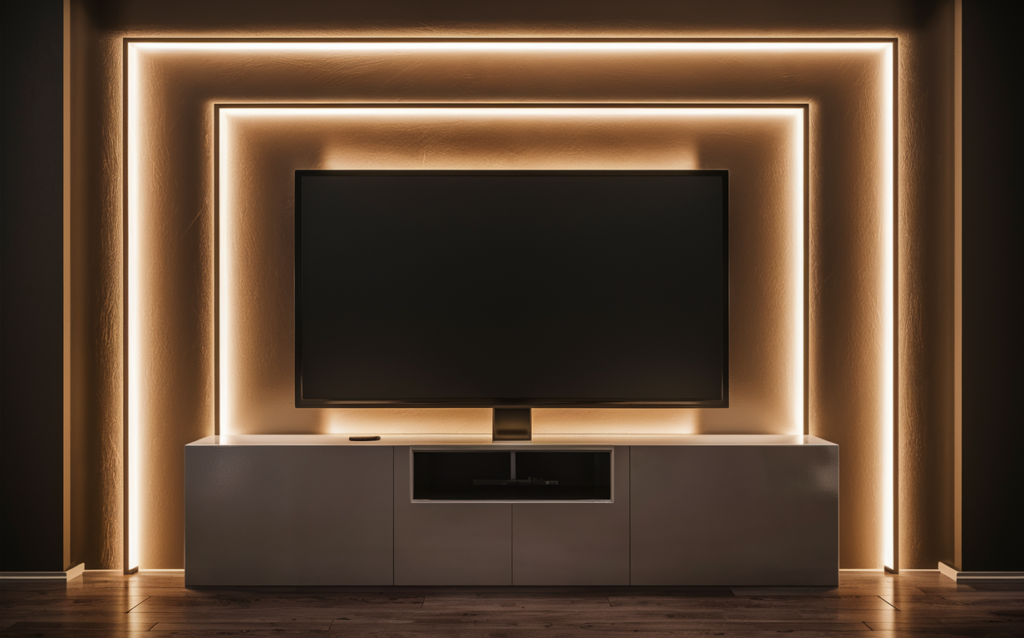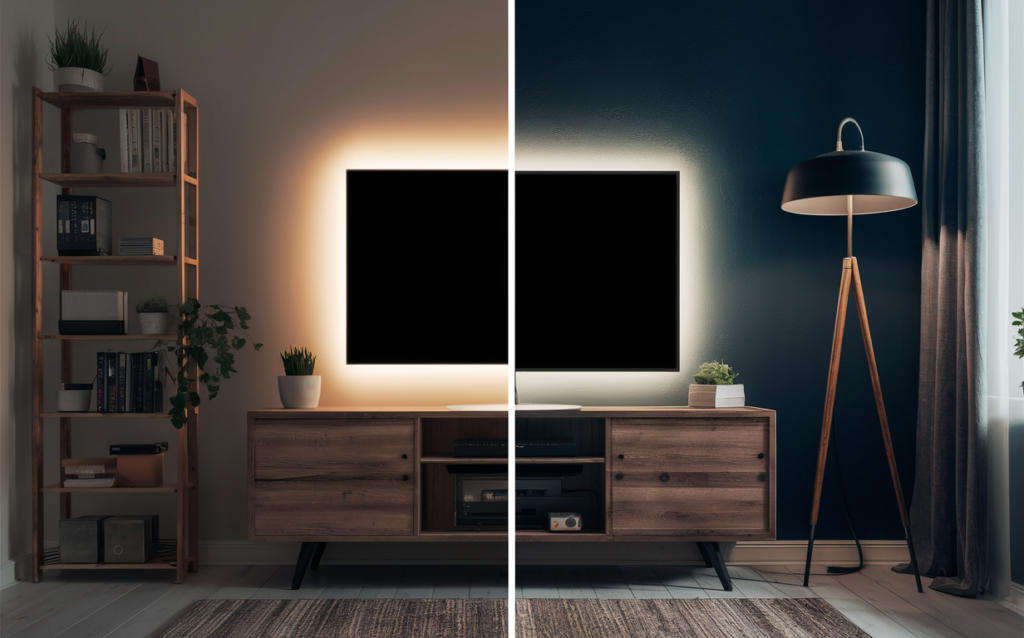
When setting up a home theater or studio, one of the most common questions that come up is, how many watts of lighting do you need for backlighting? Whether you’re building a media room for movie nights or designing a professional workspace, choosing the right lighting wattage is crucial. But with so many options available and numerous factors to consider, it’s easy to feel overwhelmed. What’s the ideal wattage for backlighting, and how do you choose the best setup for your needs?
In this article, we’ll break down everything you need to know about lighting watts for backlighting, how wattage affects light intensity, and the best practices for achieving the perfect lighting for your setup. We’ll also explore common mistakes to avoid and answer frequently asked questions to help you make an informed decision.
Understanding Backlighting and Its Importance

Before diving into the specifics of lighting watts, it’s important to first understand what backlighting is and why it’s such an essential aspect of any lighting setup.
What is Backlighting?
Backlighting is the technique of placing a light source behind an object to create a glowing effect or enhance contrast. In the context of home theaters, backlighting typically refers to placing light fixtures behind a television, computer screen, or even furniture like shelves or cabinets. The light helps to reduce eye strain, improve the visual experience, and provide a more immersive environment.
For instance, when watching a TV in a dark room, having backlight behind the screen can reduce the harsh contrast between the bright screen and the dark surroundings. This not only enhances the overall viewing experience but can also make the screen appear more vibrant.
Why Is Backlighting Important?
Backlighting serves several important purposes:
- Reduces Eye Strain: When you’re watching TV or working at a desk, backlighting provides a softer, ambient light that reduces eye strain caused by staring at a bright screen in a dark room.
- Improves Visual Comfort: Proper backlighting balances the light in your environment, making it easier to focus on your screen without discomfort.
- Aesthetic Appeal: Backlighting adds a stylish touch to any setup, giving your room a more professional, polished look.
- Enhances Contrast: By adding a light source behind a screen, the colors and contrast on the screen become more vibrant and clear.
Choosing the Right Lighting Watts for Backlighting
Now that we understand what backlighting is, let’s dive into the specifics of choosing the right wattage for your lighting setup. The wattage you need for backlighting depends on various factors, such as the size of the room, the type of lighting fixture, and the purpose of the lighting.
Factors Influencing Lighting Watts for Backlighting
Several factors determine the optimal wattage for backlighting. Understanding these factors will help you choose the right lighting setup.
1. Room Size
The size of your room plays a significant role in determining how many watts of lighting you’ll need. A larger room may require more powerful lighting, while a smaller room may need less wattage. Here’s a rough guideline:
- Small Rooms (Up to 100 sq. ft.): For a small room, you’ll generally need around 300-600 lumens of backlighting.
- Medium Rooms (100-200 sq. ft.): Medium-sized rooms usually need between 600-1200 lumens of light.
- Large Rooms (200+ sq. ft.): For larger rooms, you’ll likely need 1200 lumens or more.
2. Lighting Fixture Type
The type of backlight you choose will impact how much wattage you need. Here’s an overview of the most common types of backlighting:
- LED Strips: These are often the go-to choice for backlighting due to their energy efficiency and ease of installation. LED strips are typically low-wattage, with some options offering around 5 to 10 watts per meter.
- Smart Light Panels: These panels allow for custom lighting designs and can vary in wattage, but generally, they range from 10 to 30 watts for larger setups.
- Incandescent Bulbs: Although not as common for backlighting due to their high energy consumption, incandescent bulbs typically range from 40 to 100 watts.
3. Brightness Needs
How bright you want the backlight to be will determine how many watts you need. For instance, a subtle glow may require lower wattage, while a more intense backlight may need higher wattage. Most people prefer a backlight that provides gentle ambient light without overpowering the screen. The general guideline is to aim for around 100 to 200 lumens per square foot for backlighting.
4. Dimming Capability
Some backlighting setups come with dimming options, allowing you to adjust the intensity of the light. If you’re using a dimmable light source, you may need a higher-wattage bulb to ensure there’s enough flexibility in adjusting the brightness to suit different lighting conditions.
The Role of Lumens in Backlighting
When choosing backlighting, you may come across the term lumens. While watts measure energy consumption, lumens measure the brightness of the light output. For backlighting, it’s crucial to focus on lumens, as it directly relates to how bright or soft the light will appear on your wall or behind your screen.
Here’s how lumens correlate with wattage:
- LED lights: LED lights are more energy-efficient than incandescent or fluorescent lights, meaning they can produce the same amount of lumens while consuming fewer watts. For instance, a 10-watt LED bulb can produce the same amount of brightness as a 60-watt incandescent bulb.
- Incandescent bulbs: Traditional incandescent bulbs require more watts to produce the same level of brightness. A 60-watt incandescent bulb typically emits about 800 lumens.
- Fluorescent bulbs: Fluorescent lights are another popular option, often emitting around 80 lumens per watt.
For backlighting, you want to find a balance between brightness and energy efficiency. If you’re using an LED strip, for example, 5-10 watts per meter may be sufficient to provide a soft but noticeable glow.
Backlighting Wattage Recommendations for Different Use Cases
Different situations may require varying levels of backlighting wattage. Here are some recommendations based on common scenarios:
1. Home Theater Backlighting
For home theaters, you’ll want the backlighting to be subtle, enhancing the viewing experience without distracting from the screen. A 50 to 150-lumen backlight per meter should suffice. This will help reduce the contrast between the screen and the dark surroundings without overwhelming the space. You could use LED strips behind the TV or projector screen for optimal results.
2. Desk Setup or Work Area Backlighting
If you’re using backlighting for a desk setup or workstation, the goal is to reduce eye strain and create an ambient lighting environment. For this setup, 100 to 200 lumens per meter of backlighting is ideal. You might want to use dimmable LED light strips that allow you to adjust the brightness based on the time of day and your work tasks.
3. Decorative Backlighting
For more decorative backlighting, such as illuminating shelves, cabinets, or architectural features, you can choose higher wattage lights to create a dramatic effect. Wattages can range from 10 to 30 watts per meter, depending on the size and effect you want to achieve.
Best Practices for Setting Up Backlighting
Choosing the right wattage is just one part of the equation. Proper installation and placement also play a huge role in creating the desired effect. Here are some tips:
- Positioning: Ensure the light source is placed behind the screen or object, but not directly visible. For TVs, place the light strips or panels behind the TV at the edges for a clean, glowing effect.
- Avoid Overlighting: Too much light behind the screen can reduce the contrast and make the screen harder to view. Aim for soft, diffuse light that enhances the viewing experience without overpowering it.
- Use Dimmers: Dimmable lights give you more control over the intensity and can adjust the lighting to match the time of day or activity.
- Color Temperature: Choose a color temperature that suits your space. Warm white (2700-3000K) works well for cozy settings, while cool white (4000-5000K) is better for workspaces.
Conclusion
Backlighting is an essential part of any modern lighting setup, whether you’re creating a cinematic home theater experience or just improving your work area’s ambiance. Understanding the right lighting watts is key to ensuring your backlight provides the optimal balance of brightness, energy efficiency, and comfort.
Remember that the ideal wattage will depend on factors like room size, fixture type, and your desired brightness. It’s always a good idea to test different wattages and configurations to find the perfect setup for your needs. With the right backlighting, you can enhance your space both functionally and aesthetically.
FAQs about Lighting Watts for Backlighting
1. What’s the ideal wattage for backlighting in a home theater?
For home theater backlighting, you’ll want a soft glow. Around 50 to 150 lumens per meter of LED strips should suffice to provide a comfortable viewing experience without being too harsh.
2. Can I use incandescent bulbs for backlighting?
While incandescent bulbs are an option, they’re not as energy-efficient as LED lights. Incandescent bulbs may also generate more heat and consume more energy. LED lights are usually preferred for backlighting due to their low energy usage and brightness control.
3. What type of backlighting is best for reducing eye strain?
LED strips or smart lighting panels with dimming options work best for reducing eye strain. They provide a soft, adjustable light that reduces the contrast between a screen and its surroundings.
4. How do I calculate the number of lumens I need for backlighting?
To calculate the required lumens, consider the square footage of the area you want to backlight. For a typical home theater, aim for around 100 to 200 lumens per square foot. For smaller spaces or subtle lighting, you can reduce this amount.
5. Can I use RGB lights for backlighting?
Yes, RGB lights can be used for backlighting to create customizable color effects. They are particularly popular for gaming setups and decorative lighting. Just ensure that they provide enough lumens for the effect you want to achieve.